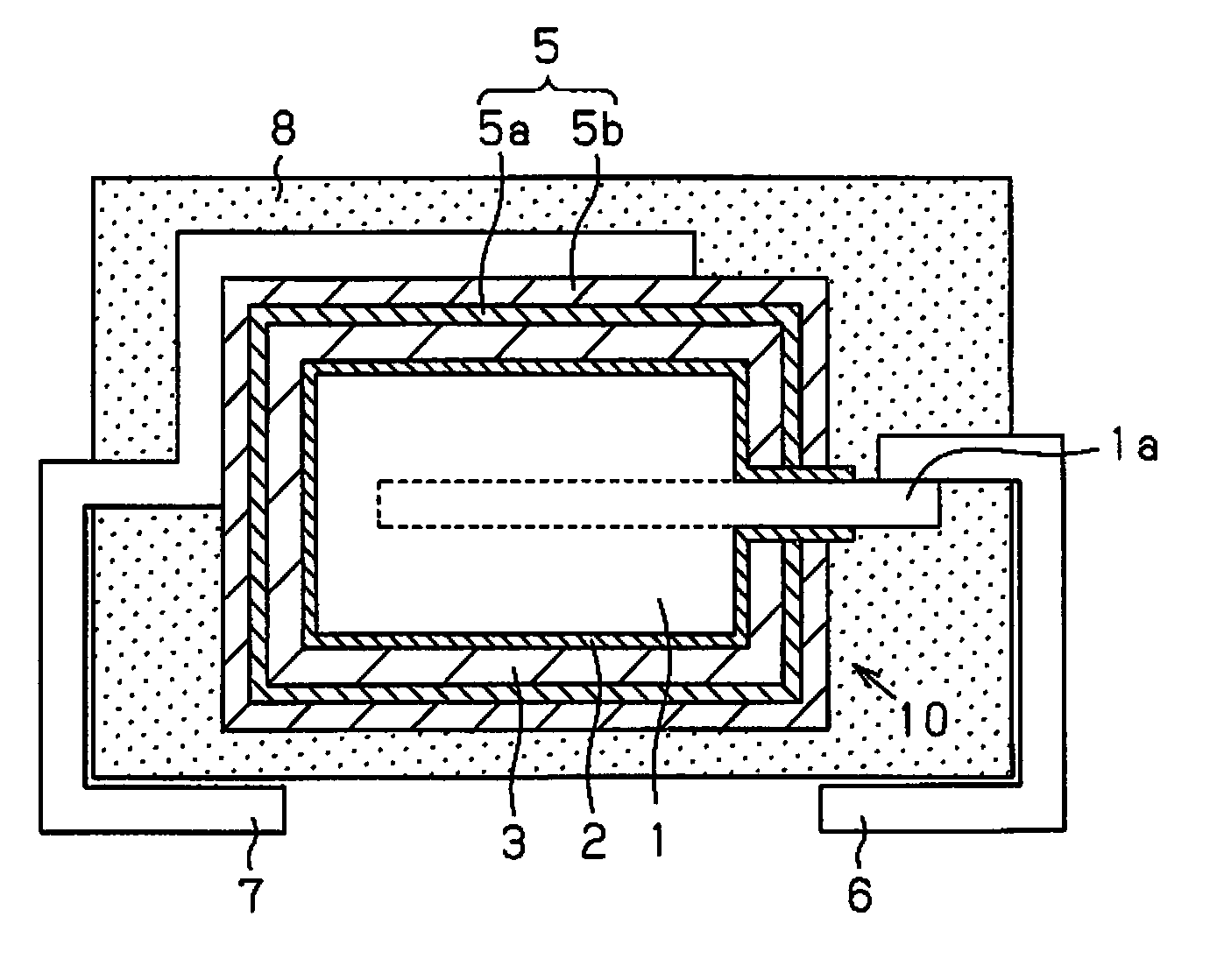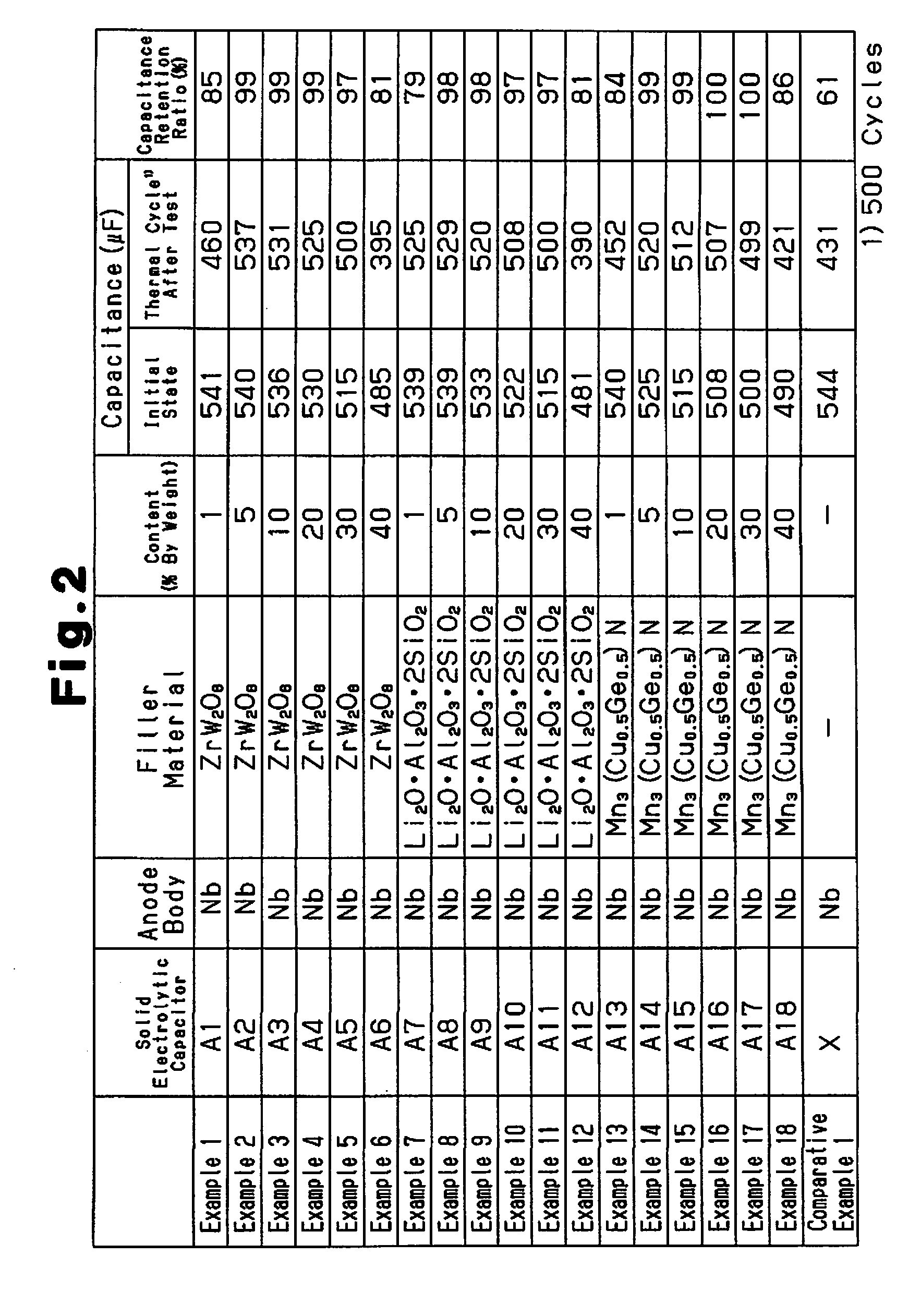Solid electrolytic capacitor
a technology of electrolytic capacitors and solids, applied in the direction of electrolytic capacitors, cell components, printing, etc., can solve the problem of reducing capacitance, and achieve the effect of suppressing the effect of capacitance decreasing
- Summary
- Abstract
- Description
- Claims
- Application Information
AI Technical Summary
Benefits of technology
Problems solved by technology
Method used
Image
Examples
example
[0037]First, as preliminary experiments 1 to 3, the content of the filler material contained in the conductive polymer layer formed through chemical polymerization was evaluated.
experiment 1
Preliminary Experiment 1
[0038]First, 20 mg of grain-like powder of zirconium tungstate (ZrW2O8), which serves as filler material, and 2 mg of para-toluenesulfonic acid iron (III), which serves as a dopant-oxidant, were uniformly mixed in 100 g of an ethanol solution containing 1% by weight of pyrrole, which serves as polymerization monomer, to prepare a chemical polymerization liquid. Then, an anode body on which a dielectric layer was formed was impregnated in the chemical polymerization liquid and left in a room temperature environment (25° C.) for twenty-four hours to advance the polymerization reaction and form a conductive polymer film (thickness: approximately 100 μm) on the dielectric layer. The formed conductive polymer film was stripped from the dielectric layer and used as analysis sample S1.
[0039]Next, a qualitative and quantitative analysis was conducted on the analysis sample S1 to quantify the zirconium tungstate in the conductive polymer film of the analysis sample S1...
experiment 2
Preliminary Experiment 2
[0040]Further, 15 mg of grain-like powder of beta-eucryptite (Li2O.Al2O3.2SiO2), which is a lithium-aluminum-silicon oxide serving as filler material, and 2 mg of para-toluenesulfonic acid iron (III), which serves as a dopant-oxidant, were uniformly mixed in 100 g of an ethanol solution containing 1% by weight of pyrrole, which serves as polymerization monomer, to prepare a chemical polymerization liquid. Then, an anode body on which a dielectric layer was formed was impregnated in the chemical polymerization liquid and left in a room temperature environment (25° C.) for twenty-four hours to advance the polymerization reaction and form a conductive polymer film (thickness: approximately 100 μm) on the dielectric layer. The formed conductive polymer film was stripped from the dielectric layer and used as analysis sample S2.
[0041]Next, a qualitative and quantitative analysis was conducted on the analysis sample S2 to quantify the beta-eucryptite in the conducti...
PUM
| Property | Measurement | Unit |
|---|---|---|
| weight | aaaaa | aaaaa |
| weight | aaaaa | aaaaa |
| temperature | aaaaa | aaaaa |
Abstract
Description
Claims
Application Information
 Login to View More
Login to View More - R&D
- Intellectual Property
- Life Sciences
- Materials
- Tech Scout
- Unparalleled Data Quality
- Higher Quality Content
- 60% Fewer Hallucinations
Browse by: Latest US Patents, China's latest patents, Technical Efficacy Thesaurus, Application Domain, Technology Topic, Popular Technical Reports.
© 2025 PatSnap. All rights reserved.Legal|Privacy policy|Modern Slavery Act Transparency Statement|Sitemap|About US| Contact US: help@patsnap.com



